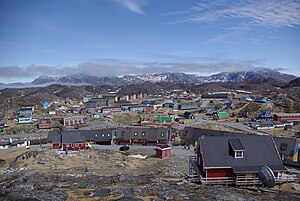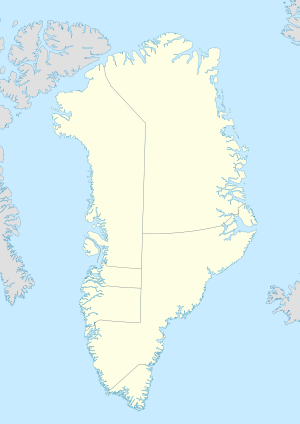Frederikshåb
|
Paamiut Frederikshåb |
|
|---|---|

Central Paamiut in early-June 2011
|
|
| Location within Greenland | |
| Coordinates: 61°59′40″N 49°40′00″W / 61.99444°N 49.66667°WCoordinates: 61°59′40″N 49°40′00″W / 61.99444°N 49.66667°W | |
| State |
|
| Constituent country |
|
| Municipality |
|
| First settled | 1500 BC |
| Founded | 1742 |
| Population (2013) | |
| • Total | 1,515 |
| Time zone | UTC-03 |
| Postal code | 3940 |
| Website | [1] Dead link |
Paamiut, formerly Frederikshåb, is a town in southwestern Greenland in the Sermersooq municipality.
Paamiut is located on the coast of Labrador Sea in the southern end of a small estuary called Kuannersooq ("Inlet").
People have lived in the Paamiut area since around 1500 BC. The name Paamiut is Kalaallisut for "Those who Reside by the Mouth (of the fiord)".
The trading post of Frederikshaab (sometimes anglicized as Frederick's Hope) was established by Jacob Severin's company in 1742 and named in honor of the Crown Prince Frederick (later King Frederick V of Denmark).
The community prospered on trading fur and whale products. It also became known for its soapstone artists. The town has one of the finest churches in Greenland, built in 1909 from wood in the Norwegian style.
Following the warming climatic trends since the 1920s, Paamiut developed a booming cod industry between the 1950s and 1989, when the stock dwindled. In connection with a development plan called G60 Paamiut was chosen as to be the place to live for the entire population of the former Paamiut municipality. Therefore, the number of people living there rose significantly during that period.
There is local museum downtown in original buildings from the previous century, among them a carpenter workshop and a salt warehouse. The Danish Crown Princely family visited the town as part of an official tour of Greenland in summer 2014.
As is the case for other towns of western Greenland, the sea is free of ice during the winter, while fishing is the primary occupation of the inhabitants of the region. Icebergs, coming adrift along the east coast of Greenland with the East Greenland Current and continuing up along the west coast with the West Greenland Current normally arrive in the autumn, bringing numerous seals marking this season as a great time for the local hunters.
...
Wikipedia

